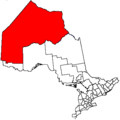This article needs additional citations for verification .(February 2024) |
Big Grassy First Nation (Mishkosiminiziibiing Anishinaabeg in the Ojibwe language) is an Ojibwe or Ontario Saulteaux First Nation band government located in Rainy River District, Ontario near Morson, Ontario.
Contents
Together with the Ojibways of Onigaming First Nation, Big Grassy First Nation is a successor apparent to the former Assabaska Band of Saulteaux. Its registered population in February, 2012 was 721, of which the on-reserve population was 228. It is a member of the Anishinabeg of Kabapikotawangag Resource Council, a regional tribal council that is a member of the Grand Council of Treaty 3.

